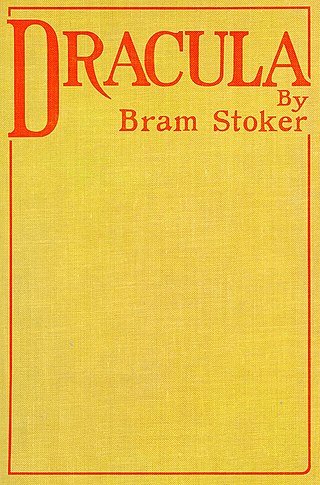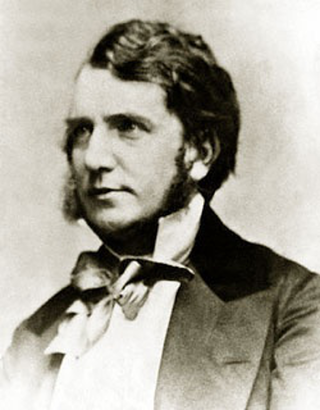
Abraham Stoker was an Irish author who wrote the 1897 Gothic horror novel Dracula. During his lifetime, he was better known as the personal assistant of actor Sir Henry Irving and business manager of the West End's Lyceum Theatre, which Irving owned.

Carmilla is an 1872 Gothic novella by Irish author Sheridan Le Fanu and one of the early works of vampire fiction, predating Bram Stoker's Dracula (1897) by 26 years. First published as a serial in The Dark Blue (1871–72), the story is narrated by a young woman preyed upon by a female vampire named Carmilla, later revealed to be Mircalla, Countess Karnstein. The character is a prototypical example of the lesbian vampire, expressing romantic desires toward the protagonist. The story is often anthologised, and has been adapted many times in film and other media.

Dracula is a novel by Bram Stoker, published in 1897. An epistolary novel, the narrative is related through letters, diary entries, and newspaper articles. It has no single protagonist, but opens with solicitor Jonathan Harker taking a business trip to stay at the castle of a Transylvanian nobleman, Count Dracula. Harker escapes the castle after discovering that Dracula is a vampire, and the Count moves to England and plagues the seaside town of Whitby. A small group, led by Abraham Van Helsing, hunt Dracula and, in the end, kill him.

Gothic fiction, sometimes called Gothic horror, is a loose literary aesthetic of fear and haunting. The name refers to Gothic architecture of the European Middle Ages, which was characteristic of the settings of early Gothic novels.

Horror is a genre of fiction that is intended to disturb, frighten or scare. Horror is often divided into the sub-genres of psychological horror and supernatural horror, which are in the realm of speculative fiction. Literary historian J. A. Cuddon, in 1984, defined the horror story as "a piece of fiction in prose of variable length... which shocks, or even frightens the reader, or perhaps induces a feeling of repulsion or loathing". Horror intends to create an eerie and frightening atmosphere for the reader. Often the central menace of a work of horror fiction can be interpreted as a metaphor for larger fears of a society.

Joseph Thomas Sheridan Le Fanu was an Irish writer of Gothic tales, mystery novels, and horror fiction. He was a leading ghost story writer of his time, central to the development of the genre in the Victorian era. M. R. James described Le Fanu as "absolutely in the first rank as a writer of ghost stories". Three of his best-known works are the locked-room mystery Uncle Silas, the lesbian vampire novella Carmilla, and the historical novel The House by the Churchyard.

Vampire literature covers the spectrum of literary work concerned principally with the subject of vampires. The literary vampire first appeared in 18th-century poetry, before becoming one of the stock figures of gothic fiction with the publication of Polidori's The Vampyre (1819), which was inspired by the life and legend of Lord Byron. Later influential works include the penny dreadful Varney the Vampire (1847); Sheridan Le Fanu's tale of a lesbian vampire, Carmilla (1872), and the most well known: Bram Stoker's Dracula (1897). Some authors created a more "sympathetic vampire", with Varney being the first, and more recent examples such as Moto Hagio's series The Poe Clan (1972-1976) and Anne Rice's novel Interview with the Vampire (1976) proving influential.
The fantastic is a subgenre of literary works characterized by the ambiguous presentation of seemingly supernatural forces.

The first Irish prose fiction, in the form of legendary stories, appeared in the Irish language as early as the seventh century, along with chronicles and lives of saints in Irish and Latin. Such fiction was an adaptation and elaboration of earlier oral material and was the work of a learned class who had acquired literacy with the coming of Latin Christianity. A number of these stories were still available in manuscripts of the late medieval period and even as late as the nineteenth century, though poetry was by that time the main literary vehicle of the Irish language.

Charles Robert Maturin, also known as C. R. Maturin, was an Irish Protestant clergyman and a writer of Gothic plays and novels. His best known work is the novel Melmoth the Wanderer.

The Jewel of Seven Stars is a horror novel by Irish writer Bram Stoker, first published by Heinemann in 1903. The story is a first-person narrative of a young man pulled into an archaeologist's plot to revive Queen Tera, an ancient Egyptian mummy. It explores common fin de siècle themes such as imperialism, the rise of the New Woman and feminism, and societal progress.
Gary William Crawford was an American writer and small press publisher.

LGBT themes in horror fiction refers to sexuality in horror fiction that can often focus on LGBTQ+ characters and themes within various forms of media. It may deal with characters who are coded as or who are openly LGBTQ+, or it may deal with themes or plots that are specific to gender and sexual minorities.

Florence Balcombe was the wife and literary executor of Bram Stoker. She is remembered for her legal dispute with the makers of Nosferatu, an unauthorized film based on her husband's novel Dracula.
Events from the year 1864 in Ireland.

Urban Gothic is a subgenre of Gothic fiction, film horror and television dealing with industrial and post-industrial urban society. It was pioneered in the mid-19th century in Britain, Ireland and the United States and developed in British novels such as Robert Louis Stevenson's Strange Case of Dr Jekyll and Mr Hyde (1886), and Irish novels such as Oscar Wilde's The Picture of Dorian Gray (1890), and Bram Stoker's Dracula (1897). In the twentieth century, urban Gothic influenced the creation of the subgenres of Southern Gothic and suburban Gothic. From the 1980s, interest in the urban Gothic revived with books like Anne Rice's Vampire Chronicles and a number of graphic novels that drew on dark city landscapes, leading to adaptations in film including Batman (1989), The Crow (1994) and From Hell (2001), as well as influencing films like Seven (1995).

Monster erotica, also referred to as monster porn or cryptozoological erotica is a subgenre of erotic literature that involves sexual encounters between humans and monsters. It sometimes crosses over with erotic horror.
Swan River Press is an independent Irish publishing company dedicated to gothic, supernatural, and fantastic literature. It was founded in Rathmines, Dublin in October 2003 by Brian J. Showers. Swan River publishes contemporary fiction from around the world with an emphasis on Ireland's past and present contributions to the genre. They also issue the non-fiction journal The Green Book: Writings on Irish Gothic, Supernatural and Fantastic Literature, and sporadically organise the Dublin Ghost Story Festival.
The Guardian's 100 best novels is a list of the best English-language novels as selected by Robert McCrum for The Guardian.

The Blood of the Vampire is a Gothic novel by Florence Marryat, published in 1897. The protagonist, Harriet Brandt, is a mixed-race psychic vampire who kills unintentionally. The novel follows Harriet after she leaves a Jamaican convent for Europe, and her ill-fated attempts to integrate with Victorian society.















